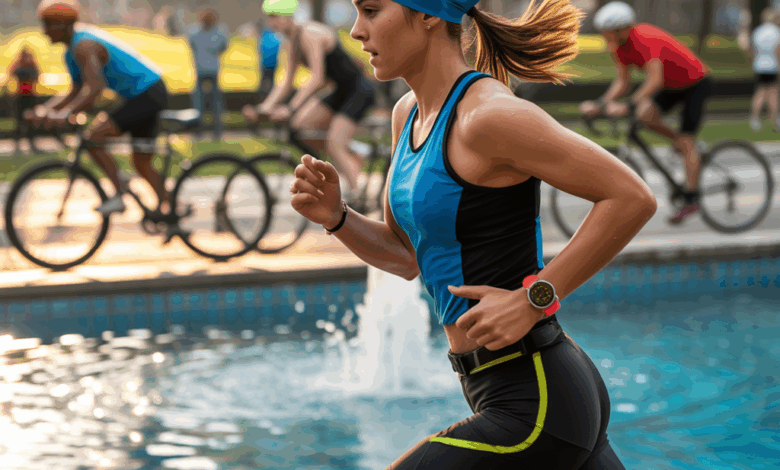Mini Triathlon Training Guide For Everyone

Have you ever pictured yourself crossing a finish line — sun on your face, arms raised — after swimming, biking and running a short race that fits into a weekend? Whether you’re a time-poor professional, a busy parent, or someone returning to fitness after a break, this mini triathlon training guide for everyone will show you how to prepare safely, efficiently, and enjoyably.
Why Choose a Mini Triathlon?
Mini triathlons (sometimes called sprint triathlons) typically include a short swim, a bike leg of 10–20 kilometers, and a 3–5 kilometer run. They’re approachable, fun, and an excellent way to build cardio fitness, confidence, and routine. If you want a realistic, low-barrier challenge that delivers big health and mood benefits, this short-distance multi-sport event fits the bill.
Benefits at a Glance
- Time-efficient training that adapts to busy schedules
- Cross-training reduces injury risk and boredom
- Scalable goals for beginners to experienced athletes
- Community and race-day excitement without the burnout of long-distance events
Mini Triathlon Training Guide for Everyone: A Practical Roadmap
This roadmap is built around three training blocks: Base (4 weeks), Build (3 weeks), and Sharpen (1–2 weeks). Adjust the volume to your level — beginners should keep intensity low and build slowly, while intermediate athletes can add more intervals and brick sessions.
Weekly Structure (Sample for 8 Weeks)
- 3 main sessions: Swim, Bike, Run (separate days)
- 1 brick session: Bike immediately followed by a short run once per week
- 2 strength or mobility sessions: Bodyweight or light weights, 20–30 minutes
- 2 rest or active recovery days: Walk, easy yoga, or light cycling
Sample Week (Beginner)
- Monday: Rest or mobility work
- Tuesday: Swim 20–30 minutes (focus on technique)
- Wednesday: Bike 30–45 minutes easy
- Thursday: Strength 20 minutes (core + glutes)
- Friday: Run 20–30 minutes easy
- Saturday: Brick — Bike 30 minutes + Run 10–15 minutes
- Sunday: Active recovery walk or yoga
Sample Week (Intermediate)
- Monday: Strength + mobility
- Tuesday: Swim 40 minutes with intervals (6x100m)
- Wednesday: Bike 45–60 minutes with tempo efforts
- Thursday: Run intervals 6x400m with jog recovery
- Friday: Easy recovery swim or rest
- Saturday: Long brick — Bike 60 minutes + Run 20 minutes
- Sunday: Active recovery
Key Workouts and Variations
Swim: Technique, Endurance, and Confidence
- Drills: Catch-up, fingertip drag, and single-arm swimming to improve form.
- Intervals: 6–8 x 50–100m with rest to build speed without excess fatigue.
- Open-water practice: If your race is not in a pool, practice sighting and swimming in open water once or twice before race day.
Bike: Efficiency and Aero Basics
- Endurance rides at conversational pace to build aerobic base.
- Tempo efforts (10–20 minutes steady) to raise lactate threshold.
- Cadence drills: Spin at higher cadence for short blocks to improve leg speed.
Run: Strength and Transition Focus
- Easy runs to build mileage and confidence.
- Intervals or fartlek for speed and leg turnover.
- Brick workouts (bike-to-run) to practice the “heavy legs” feeling and pacing.
Strength, Mobility, and Injury Prevention
A 20–30 minute strength session twice a week can dramatically reduce injury risk and improve race performance. Focus on:
- Core stability: planks, dead bugs
- Glute and hip strength: squats, lunges, single-leg deadlifts
- Shoulder stability for swimming: band external rotations, scapular work
- Mobility: hip flexor stretches, calf mobility, thoracic rotation
Nutrition, Recovery, and Lifestyle
Training smart means fueling and recovering properly. Simple rules:
- Prioritize protein and carbohydrates post-workout (e.g., yogurt + banana or a smoothie with whey and oats).
- Hydrate consistently — small amounts often beat large volumes at once.
- Sleep: aim for 7–9 hours to support adaptation.
- Stress management: short breathing exercises or a 10-minute evening walk can help recovery.
For specific meal plans and race-day fueling strategies, check our nutrition guides page.
Gear, Transitions, and Race-Day Tips
You don’t need top-of-the-line gear to succeed. Prioritize fit and comfort:
- Swim: comfortable goggles and a well-fitting suit; practice with a wetsuit if the race allows it and it’ll be cold.
- Bike: a reliable road or hybrid bike, helmet, and basic tools for roadside fixes.
- Run: comfortable trainers you’ve logged miles in.
Practice transitions (T1 and T2) at least twice during your training block. Lay your kit out, practice taking off goggles, clipping helmet, and running with shoes to reduce panicked fumbling on race day.
Mental Strategies and Real-World Examples
Training for a mini triathlon is as much mental as physical.
- Break the race into bite-sized goals: focus on getting through the swim, then the bike, then the run.
- Use mantras like “steady and strong” during the bike and “relaxed turnover” on the run.
Real example: Jane, a 38-year-old nurse with two kids, started with three 30-minute workouts a week and completed her first sprint triathlon after 10 weeks by swapping TV time for morning workouts. Mark, a 52-year-old software engineer, used this guide to return from a knee injury by prioritizing strength and low-impact bike workouts before slowly reintroducing running.
Frequently Asked Questions
Q: How long should I train before a mini triathlon?
A: For beginners, allow 8–10 weeks of consistent training with 3–6 sessions per week. If you already have a running or cycling base, 4–6 weeks focused on swim technique and transition practice may be enough.
Q: Can I train for a mini triathlon if I’m overweight or returning from injury?
A: Yes — scale sessions, prioritize low-impact options (pool work and cycling), and include strength and mobility. Consult a physician if you have serious health concerns and progress slowly to avoid setbacks.
Q: Do I need a wetsuit or tri-specific gear?
A: Not necessarily. Wetsuits help in cold open-water swims and can boost buoyancy. Tri suits save time in transitions but are optional. Invest first in proper shoes, a well-fitting helmet, and comfortable swim goggles.
Conclusion — Your Next Steps
Ready to get started? This mini triathlon training guide for everyone gives you a realistic plan, practical workouts, and lifestyle tips to cross the finish line with confidence. Begin with one week of baseline training, schedule your first open-water or pool session, and practice one brick workout this week. For specific session plans, visit our workout routines and check more wellness tips to support recovery and habit building.
Sign up for a local sprint event, set one small weekly goal, and enjoy the process — the finish line will be closer than you think.





